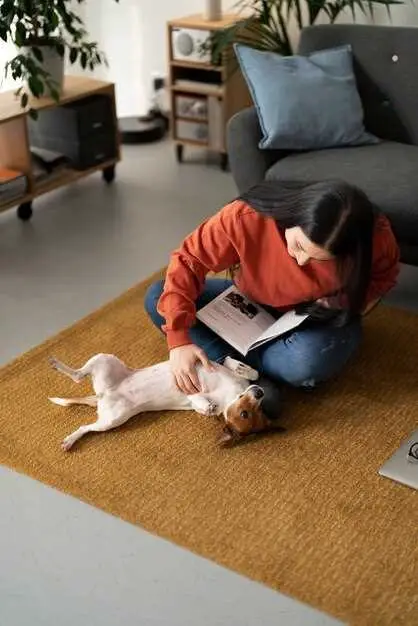
A dislocated hip can be a painful and distressing injury for your dog. While it is important to seek veterinary care for a proper diagnosis and treatment, there are a few steps you can take at home to help stabilize your dog’s dislocated hip and provide comfort until you can get them to the vet.
First, it’s crucial to keep your dog as calm and still as possible. Any excessive movement can worsen the injury and cause more pain. Restrict your dog’s activity by confining them to a small, quiet area where they can rest comfortably. Consider using a crate or a baby gate to limit their movement. Also, try to avoid touching or manipulating the injured area, as this can cause further discomfort.
In some cases, you may need to gently manipulate the dislocated hip back into place. However, it is essential to proceed with caution and seek guidance from a veterinarian before attempting this on your own. If your dog is in extreme pain or the injury is severe, it is best to leave the relocation to a professional.
While waiting to see a veterinarian, you can help alleviate your dog’s pain by applying a cold compress to the affected area. Wrap a few ice cubes in a towel or use a cold pack and gently apply it to the hip for 10-15 minutes at a time. This can help reduce swelling and numb the area, providing temporary relief.
Remember, it is crucial to seek veterinary attention as soon as possible. Dislocated hips require medical intervention, and a professional will be able to provide the necessary treatment to ensure your dog’s well-being and recovery.
Signs of a Dislocated Hip in Dogs
Dislocated hips are a common injury in dogs, especially in those that are active or involved in high-impact activities. Recognizing the signs of a dislocated hip in your furry friend is crucial in order to provide timely and appropriate treatment. Here are some common signs to look out for:
- Limping or favoring one leg
- Pain or discomfort, especially when walking or running
- Difficulty or reluctance to stand up or lay down
- Inability to use the affected leg
- Swelling or bruising around the hip area
- Visible deformity or change in the hip’s appearance
- Unusual movement or range of motion in the hip joint
If you notice any of these signs, it is important to take your dog to a veterinarian for a proper diagnosis and treatment plan. Attempting to fix a dislocated hip at home without professional guidance can lead to further injury or complications. Your vet will be able to perform a thorough examination and may recommend options such as surgery or rehabilitation therapy to address the dislocated hip and alleviate your dog’s pain and discomfort.
Assessing the Severity of the Dislocation
When your dog has a dislocated hip, it is important to assess the severity of the injury before attempting any treatment at home. This will help you determine whether you can handle the situation on your own or if you need to seek veterinary assistance.
Here are some signs that may indicate a dislocated hip:
- Visible signs of pain, like limping or reluctance to put weight on the affected leg.
- An abnormal change in gait, where your dog may appear to be hopping or dragging the affected leg.
- Swelling or bruising around the hip area.
- Inability to move the leg or a decreased range of motion.
- Whining, whimpering, or signs of distress when the hip is touched or moved.
If you notice any of these signs, it is crucial to handle your dog with care and avoid putting any pressure on the affected leg. Attempting to fix a dislocated hip at home without a proper understanding of the severity can further harm your dog or potentially worsen the injury.
In cases where the dislocation is severe or accompanied by additional injuries, such as fractures or nerve damage, immediate veterinary attention is necessary. A professional veterinarian can accurately assess the severity and provide appropriate medical intervention.
If you are unsure about the severity of the dislocation or feel uncomfortable handling the situation on your own, it is always best to consult a veterinarian. They have the knowledge and expertise to properly diagnose and treat your dog’s injury.
First Aid Steps for a Dislocated Hip
Recognizing and providing immediate first aid for a dislocated hip is crucial to minimize pain and prevent further injury. Here are the steps to follow:
- Stay calm: Keep yourself and the dog as calm as possible to avoid exacerbating the situation.
- Assess the situation: Look for signs of a dislocated hip, such as limping, difficulty standing or walking, and unusual positioning of the leg.
- Restrict movement: Carefully move the dog to a safe and quiet area, and restrict their movement as much as possible to prevent further injury.
- Apply a temporary splint: If available, immobilize the leg by splinting it. Use a board, a rolled-up towel, or any firm material to support the leg and prevent it from moving.
- Elevate the leg: Gently raise the affected leg above the level of the heart to reduce swelling and minimize pain. Use a pillow or a soft object to support the leg in an elevated position.
- Apply cold compress: To alleviate pain and reduce inflammation, apply a cold compress or an ice pack wrapped in a cloth to the affected hip. Do not apply ice directly to the skin.
- Seek veterinary help: While providing first aid is important, it is crucial to seek veterinary assistance as soon as possible. Dislocated hips require professional evaluation and treatment to ensure proper healing and recovery.
Remember, although first aid can provide immediate relief, it is essential to consult a veterinarian for a proper diagnosis and appropriate treatment plan.
When to Seek Veterinary Care

If you suspect that your dog has a dislocated hip, it is important to seek veterinary care as soon as possible. While there are home remedies that can help alleviate pain and provide temporary relief, a dislocated hip is a serious injury that requires professional attention.
Here are some situations where you should definitely seek veterinary care:
- If your dog is unable to bear weight on the affected leg
- If there is visible swelling or deformity in the hip area
- If your dog is in severe pain and shows signs of distress
- If the dislocation occurred due to a traumatic injury such as a car accident
- If your dog’s leg is cold to the touch or shows signs of poor circulation
These signs may indicate a more severe dislocation or additional injuries that need immediate attention. A veterinarian will be able to assess the situation, provide pain relief, and determine the best course of action for your dog’s recovery.
Even if you feel capable of treating a minor dislocation at home, it is still recommended to consult with a veterinarian to ensure proper diagnosis and prevent any further complications.
Remember, the well-being and health of your dog should always be the top priority. Seeking veterinary care promptly can help provide the best possible outcome for your furry friend.
Preventing Dislocated Hips in Dogs
Dislocated hips can be a painful and debilitating condition for dogs. However, there are steps you can take to help prevent this injury from occurring in the first place.
1. Maintain a healthy weight: It’s important to keep your dog at a healthy weight to prevent unnecessary stress on their joints, including the hips. Obesity can put extra strain on the joints and increase the risk of dislocation.
2. Regular exercise: Exercise helps to build strong muscles and maintain flexibility, which can help support the hips and prevent dislocation. Consult with your veterinarian to determine an appropriate exercise routine for your dog based on their age, breed, and overall health.
3. Avoid high-impact activities: Certain activities like jumping from high surfaces or rough play can increase the risk of hip dislocation. Monitor your dog’s activities and discourage behaviors that could put excessive strain on the hips.
4. Provide a safe environment: Make sure your home is free from hazards that could cause your dog to slip, fall, or sustain a traumatic injury. Keep floors clear of clutter and provide stable walking surfaces to reduce the risk of accidents.
5. Regular veterinary check-ups: Regular visits to the vet can help identify any early signs of joint problems or underlying conditions that could increase the risk of hip dislocation. Your vet can provide guidance on preventive measures specific to your dog’s needs.
By following these preventive measures, you can help reduce the risk of dislocated hips in your dog and ensure they lead a healthy and active life. Remember, if you notice any signs of discomfort or mobility issues in your dog, it’s important to seek veterinary attention promptly.
| Weight Management | Regular Exercise | Avoid High-Impact Activities | Safe Environment | Regular Veterinary Check-ups |
|---|---|---|---|---|
| ✓ | ✓ | ✓ | ✓ | ✓ |